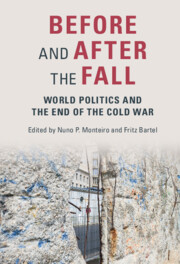Book contents
- Before and After the Fall
- Before and After the Fall
- Copyright page
- Dedication
- Epigraph
- Contents
- Figures
- Tables
- Contributors
- Preface
- Introduction
- Part I Sources of Continuity and Change
- 1 Overcoming Stagnation
- 2 Mikhail Gorbachev
- 3 Peace Through Strength and Quiet Diplomacy
- 4 “Keeping Them Well Behind”
- 5 Only One Way Forward
- Part II Continuity and Change Across the 1989/1991 Divide
- Part III Toward a New World Order?
- Index
1 - Overcoming Stagnation
Global Finance and the Search for “New Thinking” on the End of the Cold War
from Part I - Sources of Continuity and Change
Published online by Cambridge University Press: 02 December 2021
- Before and After the Fall
- Before and After the Fall
- Copyright page
- Dedication
- Epigraph
- Contents
- Figures
- Tables
- Contributors
- Preface
- Introduction
- Part I Sources of Continuity and Change
- 1 Overcoming Stagnation
- 2 Mikhail Gorbachev
- 3 Peace Through Strength and Quiet Diplomacy
- 4 “Keeping Them Well Behind”
- 5 Only One Way Forward
- Part II Continuity and Change Across the 1989/1991 Divide
- Part III Toward a New World Order?
- Index
Summary
The scholarly debate on the causes of the end of the Cold War has placed significant emphasis on the role of communist economic stagnation in bringing about the collapse of communism. This chapter brings a new material factor – communist sovereign debt – to the forefront, and in so doing, it offers a redefinition of the materialist explanation for the end of the Cold War. The global financial history of the end of the Cold War has four important implications. First, it makes the timing of the end of the Cold War far less contingent upon Gorbachev’s rise than previously thought. Second, it allows us to refine the causal connection between Soviet relative decline and the peaceful nature of the end of the Cold War. Third, global financial history transforms our understanding of Western leverage over the events that comprise the end of the Cold War. And fourth, the history of sovereign debt in the Eastern Bloc de-exceptionalizes the revolutions of 1989 in world history and places them within the context of broader global currents that continue to this day.
Keywords
- Type
- Chapter
- Information
- Before and After the FallWorld Politics and the End of the Cold War, pp. 27 - 44Publisher: Cambridge University PressPrint publication year: 2021



